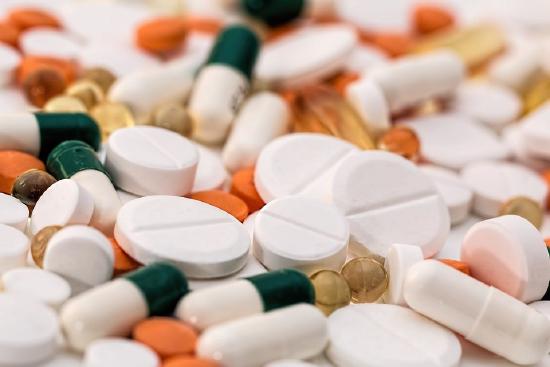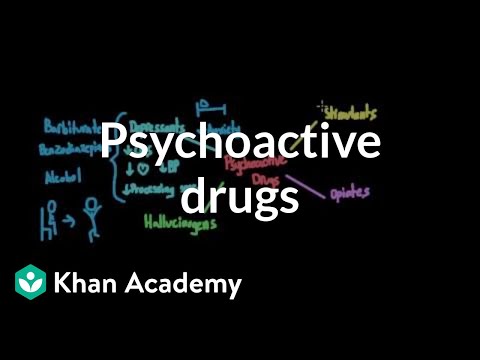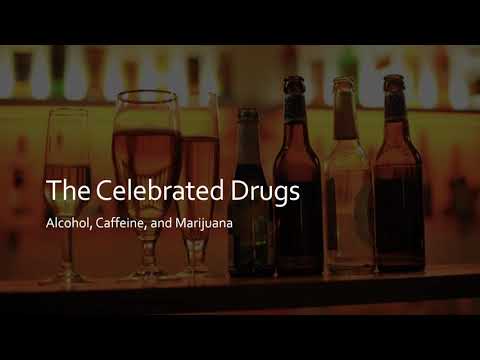1.3: An Overview of Pharmacology
- Page ID
- 91899
Having a working knowledge of the various psychoactive substances that are commonly used for recreational and medicinal purposes is important. It would be nearly impossible to maintain a list of all such substances because there are always new drugs being made, often in an attempt to avoid the legal restrictions placed on known drugs. However, a relatively small number of drugs actually create enough of an effect for people to repeatedly seek them out for their high. In this chapter, we highlight some of the primary drugs – and categories of drugs – that fall under this description.

Most people will recognize the names of many of these drugs in the table below. Alcohol, marijuana, heroin, cocaine, nicotine, ecstasy, and methamphetamine are well-known substances that can lead to the three Cs of addiction: compulsion, loss of control, and consequences.
This chapter begins with a video on psychoactive drugs to offer a context for the general categories of addictive drugs. There is also an interactive data chart created by the Substance Abuse and Mental Health Services Administration (SAMHSA) that allows you to compare drug use trends over time.
After that, you can view a chart highlighting the prevalence of several drugs of abuse, followed by a table listing of the most common drugs of abuse along with their uses, signs of intoxication, physiological effects, routes of administration, and withdrawal symptoms.
Next is a presentation on blood-alcohol concentration (BAC) that describes alcohol metabolism, factors that influence BAC, and drinking and driving laws.
The chapter concludes with The Celebrated Drugs, a look at three drugs that are widely recognized and promoted in modern U.S. culture. These drugs are alcohol, caffeine, and marijuana. That last one might surprise some people, especially if you grew up in a time when marijuana was considered just as dangerous as drugs like cocaine and heroin. However, marijuana has gained significant acceptance, along with innumerable references in music, movies, and media.
Many drugs can alter a person’s thinking and judgment and can lead to health risks, including addiction, drugged driving, infectious disease, and adverse effects on pregnancy. Information on commonly used drugs with the potential for misuse or addiction can be found here: Commonly Used Drugs: Developed by the National Institute on Drug Abuse.
Use the chart of Commonly Used Drugs to answer the following questions:
https://cod.pressbooks.pub/addiction/?p=92
Activity
Using the interactive Substance Abuse and Mental Health Data Archive, find the following information:
- For 2017-2018, what was the prevalence of marijuana use among people 12 and older in the past month?
- How does past-month alcohol use compare in 2017-2018 to 10 years earlier: higher, lower, or the same (within 1%)?
- Which region had the lowest rate of past-month alcohol use by people age 18 and over: Midwest, New England, West Coast, or South?
- Choose the description that best matches the trends in marijuana and cigarette use since 2010:
- Both cigarette and marijuana use are increasing
- Cigarette use is increasing and marijuana use is decreasing
- Cigarette use is decreasing and marijuana use is increasing
- Both cigarette and marijuana use are decreasing
- The prevalence of pain reliever misuse among adults 18 and over is approximately what percentage: 2%, 4%, 6%, or 8%?
National Survey of Drug Use and Health: Trends in Prevalence of Various Drugs
| Drug | Time Period | Ages 12 or Older | Ages 12 to 17 | Ages 18 to 25 | Ages 26 or Older | ||||||||
|---|---|---|---|---|---|---|---|---|---|---|---|---|---|
| 2016 | 2017 | 2018 | 2016 | 2017 | 2018 | 2016 | 2017 | 2018 | 2016 | 2017 | 2018 | ||
| Alcohol | Lifetime | 80.2 | 80.9 | 80.8 | 27 | 27.1 | 26.3 | 81.3 | 81.1 | 79.9 | 86.4 | 87.1 | 87.3 |
| Past Year | 64.8 | 65.7 | 65.5 | 21.6 | 21.9 | 20.8 | 74.4 | 74 | 73.1 | 68.4 | 69.5 | 69.5 | |
| Past Month | 50.7 | 51.7 | 51.1 | 9.2 | 9.9 | 9 | 57.1 | 56.3 | 55.1 | 54.6 | 55.8 | 55.3 | |
| Cigarettes (any use) | Lifetime | 57.4 | 57.1 | 55.7 | 11.6 | 10.8 | 9.6 | 50.5 | 49.5 | 45.9 | 64 | 63.8 | 62.6 |
| Past Year | 22.7 | 21.5 | 21 | 7.2 | 6.3 | 5.5 | 31.7 | 31 | 27.9 | 23.1 | 21.7 | 21.7 | |
| Past Month | 19.1 | 17.9 | 17.2 | 3.4 | 3.2 | 2.7 | 23.5 | 22.3 | 19.1 | 20.2 | 18.9 | 18.5 | |
| Smokeless Tobacco | Lifetime | 16.1 | 16.1 | 15.6 | 4.7 | 5 | 4.4 | 18.2 | 18 | 16.7 | 17.1 | 17.1 | 16.7 |
| Past Year | 4.4 | 4.3 | 4 | 3 | 3 | 2.5 | 8 | 7.7 | 7.1 | 4 | 3.9 | 3.7 | |
| Past Month | 3.3 | 3.2 | 2.9 | 1.4 | 1.3 | 1.1 | 5.2 | 4.8 | 4.4 | 3.1 | 3.1 | 2.9 | |
| Illicit Drugs | Lifetime | 48.5 | 49.5 | 49.2 | 23 | 23.9 | 23.9 | 56.3 | 57 | 55.6 | 50.2 | 51.3 | 51.2 |
| Past Year | 18 | 19 | 19.4 | 15.8 | 16.3 | 16.7 | 37.7 | 39.4 | 38.7 | 15 | 16.1 | 16.7 | |
| Past Month | 10.6 | 11.2 | 11.7 | 7.9 | 7.9 | 8 | 23.2 | 24.2 | 23.9 | 8.9 | 9.5 | 10.1 | |
| Cocaine | Lifetime | 14.4 | 14.9 | 14.7 | 0.9 | 0.7 | 0.7 | 11.3 | 12 | 11.4 | 16.6 | 17 | 16.8 |
| Past Year | 1.9 | 2.2 | 2 | 0.5 | 0.5 | 0.4 | 5.6 | 6.2 | 5.8 | 1.4 | 1.7 | 1.6 | |
| Past Month | 0.7 | 0.8 | 0.7 | 0.1 | 0.1 | 0 | 1.6 | 1.9 | 1.5 | 0.6 | 0.7 | 0.7 | |
| Crack Cocaine | Lifetime | 3.3 | 3.5 | 3.4 | 0.1 | 0.1 | 0.1 | 1.1 | 1.3 | 1 | 4 | 4.3 | 4.1 |
| Past Year | 0.3 | 0.3 | 0.3 | 0 | 0.1 | 0 | 0.3 | 0.3 | 0.3 | 0.4 | 0.4 | 0.3 | |
| Past Month | 0.2 | 0.2 | 0.2 | 0 | 0 | 0 | 0 | 0.1 | 0.1 | 0.2 | 0.2 | 0.2 | |
| Hallucinogens | Lifetime | 15.4 | 15.5 | 15.8 | 2.7 | 2.8 | 2.3 | 17.2 | 17.1 | 16.4 | 16.6 | 16.7 | 17.3 |
| Past Year | 1.8 | 1.9 | 2 | 1.8 | 2.1 | 1.5 | 6.9 | 7 | 6.9 | 1 | 1 | 1.3 | |
| Past Month | 0.5 | 0.5 | 0.6 | 0.5 | 0.6 | 0.6 | 1.9 | 1.7 | 1.7 | 0.3 | 0.3 | 0.4 | |
| Heroin | Lifetime | 1.8 | 1.9 | 1.9 | 0.1 | 0.1 | 0.1 | 1.6 | 1.8 | 1.3 | 2.1 | 2.2 | 2.2 |
| Past Year | 0.4 | 0.3 | 0.3 | 0.1 | 0.1 | 0 | 0.7 | 0.6 | 0.5 | 0.3 | 0.3 | 0.3 | |
| Past Month | 0.2 | 0.2 | 0.1 | 0 | 0 | 0 | 0.3 | 0.3 | 0.2 | 0.2 | 0.2 | 0.1 | |
| Inhalants | Lifetime | 9.1 | 9.3 | 9.1 | 8.3 | 8.6 | 8.5 | 9.8 | 9.5 | 9 | 9 | 9.3 | 9.1 |
| Past Year | 0.6 | 0.6 | 0.7 | 2.2 | 2.3 | 2.7 | 1.4 | 1.6 | 1.5 | 0.3 | 0.3 | 0.4 | |
| Past Month | 0.2 | 0.2 | 0.2 | 0.6 | 0.6 | 0.7 | 0.4 | 0.5 | 0.4 | 0.2 | 0.1 | 0.1 | |
| LSD | Lifetime | 9.6 | 9.6 | 10 | 1.2 | 1.5 | 1.3 | 8.3 | 9.1 | 9.8 | 10.8 | 10.6 | 11 |
| Past Year | 0.7 | 0.8 | 0.8 | 0.8 | 1 | 0.8 | 3.4 | 3.8 | 3.5 | 0.3 | 0.3 | 0.4 | |
| Past Month | 0.1 | 0.2 | 0.2 | 0.2 | 0.2 | 0.2 | 0.6 | 0.8 | 0.7 | 0.1 | 0.1 | 0.1 | |
| Marijuana/ Hashish | Lifetime | 44 | 45.2 | 45.3 | 14.8 | 15.3 | 15.4 | 51.8 | 52.7 | 51.5 | 46.2 | 47.5 | 47.8 |
| Past Year | 13.9 | 15 | 15.9 | 12 | 12.4 | 12.5 | 33 | 34.9 | 34.8 | 11 | 12.2 | 13.3 | |
| Past Month | 8.9 | 9.6 | 10.1 | 6.5 | 6.5 | 6.7 | 20.8 | 22.1 | 22.1 | 7.2 | 7.9 | 8.6 | |
| MDMA | Lifetime | 6.9 | 7 | 7.3 | 1.2 | 1 | 0.8 | 11.6 | 12 | 10.5 | 6.7 | 7 | 7.5 |
| Past Year | 0.9 | 0.9 | 0.9 | 0.7 | 0.7 | 0.5 | 3.5 | 3.5 | 3.1 | 0.5 | 0.5 | 0.6 | |
| Past Month | 0.2 | 0.2 | 0.3 | 0.1 | 0.2 | 0.2 | 0.9 | 0.7 | 0.7 | 0.1 | 0.1 | 0.2 | |
| Methamphetamine | Lifetime | 5.4 | 5.4 | 5.4 | 0.3 | 0.3 | 0.3 | 2.4 | 3 | 2.5 | 6.5 | 6.4 | 6.5 |
| Past Year | 0.5 | 0.6 | 0.7 | 0.1 | 0.2 | 0.2 | 0.8 | 1.1 | 0.8 | 0.5 | 0.6 | 0.7 | |
| Past Month | 0.2 | 0.3 | 0.4 | 0 | 0.1 | 0.1 | 0.2 | 0.4 | 0.3 | 0.3 | 0.3 | 0.4 | |
| PCP | Lifetime | 2.4 | 2.2 | 2.2 | 0.2 | 0.2 | 0.1 | 0.7 | 0.8 | 0.6 | 2.9 | 2.7 | 2.7 |
| Past Year | 0 | 0 | 0 | 0.1 | 0.1 | 0.1 | 0 | 0.1 | 0 | 0 | 0 | 0 | |
| Past Month | 0 | 0 | 0 | 0 | 0 | 0 | 0 | 0 | 0 | 0 | 0 | 0 | |
| Tranquilizers | Lifetime | 0 | 0 | - | 0 | 0 | - | 0 | 0 | - | 0 | 0 | - |
| Past Year | 2.2 | 2.2 | 2.1 | 1.7 | 1.8 | 1.7 | 5.3 | 5.5 | 4.6 | 1.8 | 1.7 | 1.7 | |
| Past Month | 0.7 | 0.6 | 0.6 | 0.5 | 0.5 | 0.3 | 1.5 | 1.6 | 1.2 | 0.6 | 0.5 | 0.5 | |
| Psychotherapeutics (Nonmedical Use) | Lifetime | 0 | 0 | - | 0 | 0 | - | 0 | 0 | - | 0 | 0 | - |
| Past Year | 6.9 | 6.6 | 6.2 | 5.3 | 4.9 | 4.8 | 14.5 | 14.4 | 12.3 | 5.9 | 5.6 | 5.3 | |
| Past Month | 2.3 | 2.2 | 2 | 1.6 | 1.5 | 1.3 | 4.6 | 4.5 | 3.7 | 2 | 1.9 | 1.8 | |
| Pain Relievers | Lifetime | 0 | 0 | - | 0 | 0 | - | 0 | 0 | - | 0 | 0 | - |
| Past Year | 4.3 | 4.1 | 3.6 | 3.5 | 3.1 | 2.8 | 7.1 | 7.2 | 5.5 | 3.9 | 3.7 | 3.4 | |
| Past Month | 1.2 | 1.2 | 1 | 1 | 0.9 | 0.6 | 1.8 | 1.8 | 1.4 | 1.2 | 1.1 | 1 | |
| Sedatives | Lifetime | 0 | 0 | - | 0 | 0 | - | 0 | 0 | - | 0 | 0 | - |
| Past Year | 0.6 | 0.5 | 0.4 | 0.4 | 0.3 | 0.3 | 0.7 | 0.6 | 0.6 | 0.6 | 0.5 | 0.4 | |
| Past Month | 0.2 | 0.1 | 0.1 | 0.1 | 0.1 | 0 | 0.1 | 0.2 | 0.1 | 0.2 | 0.1 | 0.1 | |
| Stimulants | Lifetime | 0 | 0 | - | 0 | 0 | - | 0 | 0 | - | 0 | 0 | - |
| Past Year | 2.1 | 2.1 | 1.9 | 1.7 | 1.8 | 1.5 | 7.5 | 7.4 | 6.5 | 1.3 | 1.3 | 1.2 | |
| Past Month | 0.6 | 0.7 | 0.6 | 0.4 | 0.5 | 0.5 | 2.2 | 2.1 | 1.7 | 0.4 | 0.5 | 0.4 |
The table below highlights the major categories of drugs of abuse. Each category includes examples, uses, routes of administration, signs of intoxication, effects, and withdrawal symptoms. Note that alcohol and benzodiazepines are chemically similar, and both can lead to severe and potentially deadly withdrawal. For this reason, chronic users of these drugs should receive medical supervision during withdrawal.
| SEDATIVES / DEPRESSANTS | NICOTINE | OPIOIDS | STIMULANTS | |
|---|---|---|---|---|
| EXAMPLES | Alcohol
Barbiturates Seconal, Phenobarbitol |
Cigarettes
Cigars Pipes Chewing tobacco |
Heroin
Morphine Codeine Vicodin Oxycontin Dilaudid Fentanyl |
Cocaine
Caffeine Amphetamine Methamphetamine Ritalin, Adderall |
| USES | Recreational; alcohol withdrawal; treat anxiety; anti-convulsant | Recreational; smoking cessation | Pain relievers | Recreational; ADHD treatment; surgical anesthetic |
| ROUTES OF ADMINISTRATION | Oral (pills and liquid); crushed & snorted | Smoked; oral absorption | Oral, snorted, IV, smoked | Oral, snorted, IV, smoked |
| SIGNS OF INTOXICATION | Slurred speech; loss of coordination; sleepiness; impaired judgment; benzos can cause amnesia | N/A (Nicotine is poisonous but leaves the body rapidly after ingestion) | Nodding; depressed respiration rate; severe drowsiness; decreased motor activity; incoherent | Hyper-arousal; increased heart rate and breathing; rapid speech; paranoia |
| PHYSIOLOGICAL EFFECTS | Altered brain function; cognitive impairment; Lowered heart rate, respiration, and BP | Initially increases, then decreases respiration and heart rate; rapidly acts in the lungs and moves to the brain; related to many types of cancer, brain damage, COPD | Decreased respiration; used to alleviate or prevent pain; intense high when misused; overdoses are usually associated with adulterants | Increased respiration, heart rate, and BP; impairment in motor function; cognitive deficits |
| WITHDRAWAL SYMPTOMS | Increased heart rate and BP; Delerium Tremens; anxiety; sweating, fever; dizziness; personality changes | Intense craving for more of the drug; irritability | Diarrhea; profuse sweating; shaking; fever; nausea; sleeplessness; “flu-like symptoms” | Depressed mood; irritability; headaches; possible psychosis; anxiety; sleep disturbances; anhedonia |
| HALLUCINOGENS | INHALANTS | MARIJUANA | DISSOCIATIVES | |
|---|---|---|---|---|
| EXAMPLES | Psilocybin
Flowers, edibles, oils |
PCP
Ketamine Dextromethorphan Salvia divinorum Nitrous oxide |
||
| USES | Recreational; couples therapy (MDMA) | Recreational; no medical benefit | Recreational; pain management; appetite stimulant | Recreational; surgery; depression treatment |
| SIGNS OF
INTOXICATION |
Nonsensical thoughts and speech; visual & auditory hallucinations (tactile hallucinations also possible) | Visible red marks around the lips and nose; incoherent speech; uncoordinated movement | Bloodshot eyes; possible hallucinations; decreased motor coordination | Hallucinations; feelings of detachment |
| PHYSIOLOGICAL EFFECTS | Acute or chronic psychotic episodes; flashbacks | Irregular heartbeat (possible death); Significant damage to brain cells, causing irreversible damage; psychiatric and neurological problems; headaches; sensitivity to light | Difficulty forming short-term memories; increased onset of mental illness; orthostatic hypotension; peripheral neuropathy; increased risk of lung damage and cancer | Memory loss; changes in blood pressure; slowed heart rate and respiration; feelings of extreme panic; aggression; respiratory arrest |
| WITHDRAWAL SYMPTOMS | Cravings; irritability | Anxiety, depression, irritability; aggressive behavior; hallucinations | Insomnia; disturbances in sleeping and dreaming; anxiety; change of appetite; weight loss; irritability | Cravings; headaches; sweating; depression; social withdrawal |
*Ecstasy, or MDMA, has several effects and is technically an entactogen. It has properties of stimulants and hallucinogens.
Activity
Click the following link to view an activity developed by the University of Utah that highlights brain changes related to methamphetamine use: METH MOUSE
Activity
Use the flashcards below to test yourself on several drug definitions.
https://cod.pressbooks.pub/addiction/?p=92
Click through the presentation below to explore information on blood-alcohol concentration.
https://cod.pressbooks.pub/addiction/?p=92




